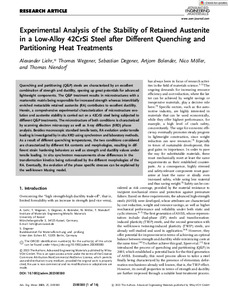| dc.date.accessioned | 2023-10-18T14:33:36Z | |
| dc.date.available | 2023-10-18T14:33:36Z | |
| dc.date.issued | 2023-06-21 | |
| dc.identifier | doi:10.17170/kobra-202310188873 | |
| dc.identifier.uri | http://hdl.handle.net/123456789/15115 | |
| dc.description.sponsorship | Gefördert im Rahmen des Projekts DEAL | ger |
| dc.language.iso | eng | |
| dc.rights | Attribution-NonCommercial-NoDerivatives 4.0 International | * |
| dc.rights.uri | http://creativecommons.org/licenses/by-nc-nd/4.0/ | * |
| dc.subject | in situ characterizations | eng |
| dc.subject | microstructures | eng |
| dc.subject | quenching and partitioning steels | eng |
| dc.subject | synchrotron diffraction | eng |
| dc.subject | transformation-induced plasticity effects | eng |
| dc.subject | X-ray diffraction | eng |
| dc.subject.ddc | 600 | |
| dc.title | Experimental Analysis of the Stability of Retained Austenite in a Low-Alloy 42CrSi Steel after Different Quenching and Partitioning Heat Treatments | eng |
| dc.type | Aufsatz | |
| dcterms.abstract | Quenching and partitioning (Q&P) steels are characterized by an excellent combination of strength and ductility, opening up great potentials for advanced lightweight components. The Q&P treatment results in microstructures with a martensitic matrix being responsible for increased strength whereas interstitially enriched metastable retained austenite (RA) contributes to excellent ductility. Herein, a comprehensive experimental characterization of microstructure evolution and austenite stability is carried out on a 42CrSi steel being subjected to different Q&P treatments. The microstructure of both conditions is characterized by scanning electron microscopy as well as X-ray diffraction (XRD) phase analysis. Besides macroscopic standard tensile tests, RA evolution under tensile loading is investigated by in situ XRD using synchrotron and laboratory methods. As a result of different quenching temperatures, the two conditions considered are characterized by different RA contents and morphologies, resulting in different strain hardening behaviors as well as strength and ductility values under tensile loading. In situ synchrotron measurements show differences in the transformation kinetics being rationalized by the different morphologies of the RA. Eventually, the evolution of the phase specific stresses can be explained by the well-known Masing model. | eng |
| dcterms.accessRights | open access | |
| dcterms.creator | Liehr, Alexander | |
| dcterms.creator | Wegener, Thomas | |
| dcterms.creator | Degener, Sebastian | |
| dcterms.creator | Bolender, Artjom | |
| dcterms.creator | Möller, Nico | |
| dcterms.creator | Niendorf, Thomas | |
| dcterms.extent | 16 Seiten | |
| dc.relation.doi | doi:10.1002/adem.202300380 | |
| dc.subject.swd | In situ | ger |
| dc.subject.swd | Mikrostruktur | ger |
| dc.subject.swd | Synchrotron | ger |
| dc.subject.swd | Röntgenbeugung | ger |
| dc.subject.swd | Austenit | ger |
| dc.subject.swd | Stahl | ger |
| dc.type.version | publishedVersion | |
| dcterms.source.identifier | eissn:1527-2648 | |
| dcterms.source.issue | Issue 17 | |
| dcterms.source.journal | Advanced Engineering Materials | eng |
| dcterms.source.volume | Volume 25 | |
| kup.iskup | false | |
| dcterms.source.articlenumber | 2300380 | |


